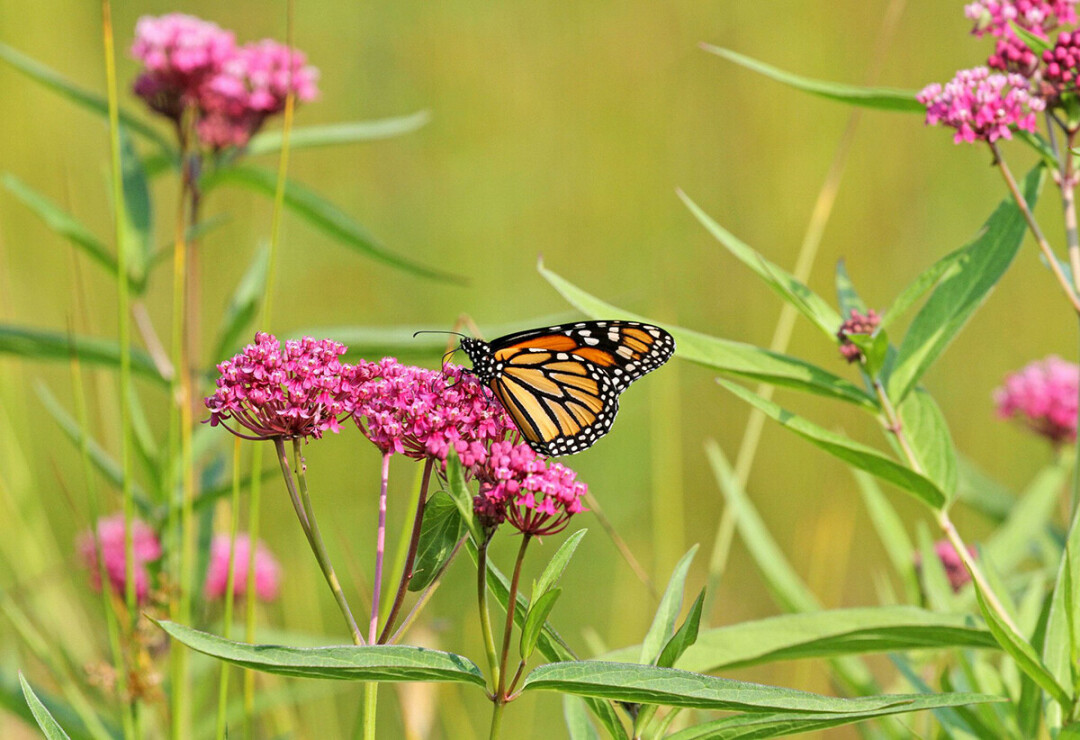Monarch Habitat Takes Off in Wisconsin
hundreds of thousands more acres available for migrating butterflies
Wisconsin Department of Natural Resources

Wisconsin monarchs looking for milkweed to lay their eggs on will now find hundreds of thousands of more acres of habitat in Wisconsin thanks to voluntary efforts by organizations and individuals statewide, including representatives from the Wisconsin Department of Natural Resources.
The Wisconsin Monarch Collaborative formed in 2018 to voluntarily plant milkweed and wildflowers on a massive scale. The collaborative’s efforts are essential to help reverse an 80% decline over the last 20 years in the Eastern population of monarchs that breed and migrate through Wisconsin and 15 other states.
Participants in the Wisconsin Monarch Collaborative include DNR representatives and other state and federal agencies, utilities, transportation groups, agriculture groups, university researchers, conservation groups, and nature centers.
“Wisconsin Monarch Collaborative partners have made a solid initial down payment on our statewide goal,” said Brenna Jones, DNR conservation biologist and Wisconsin Monarch Collaborative coordinator.
The group advises that adding and maintaining habitat is an important factor in reversing monarchs’ decline. The group encourages planting and maintaining native milkweed and native wildflowers. Milkweeds are the only source of food monarch caterpillars will eat and adult monarchs feed on a wide variety of native wildflowers.
Collaborative members committed to voluntarily adding 120 million new stems of milkweed, along with other native wildflowers, as Wisconsin’s contribution to a larger regional strategy.
“There is an unprecedented level of attention and funding now going to monarch and other pollinator habitats both nationally and in Wisconsin. Governments, nonprofits, and individuals are all focusing on the task.” –Brenna Jones, DNR conservation biologist
The group’s “Key Accomplishments 2018-2020” report released earlier this year shows monarch habitat taking flight in Wisconsin, reflecting these accomplishments:
- 105,000 reported new or enhanced acres of habitat, the bulk of it on DNR State Natural Areas
- 205,268 acres enrolled in the U.S. Department of Agriculture’s Conservation Reserve Program
- 822 monarch specific conservation projects assisted by Pheasants Forever Farm Bill Biologists
- Six major demonstration sites to teach and inspire, including at two rest areas along Interstate 39/90/94 west of Madison
- 85,000 copies of Wisconsin plant list for monarchs sent directly to Wisconsin homes
- 184 Wisconsin organizations and individuals have taken the pledge to help monarchs
“Wisconsin Monarch Collaborative members expect that the pace of milkweeds and nectar plants added to Wisconsin’s landscape will pick up,” Jones said. “There is an unprecedented level of attention and funding now going to monarch and other pollinator habitats both nationally and in Wisconsin. Governments, nonprofits, and individuals are all focusing on the task.”
Andrew Wallendal, co-leader of the collaborative’s agricultural working group, said many farmers are growing much-needed products and providing ecosystem services of pollinator habitats.
“These growers are unsung heroes that need to be recognized,” Wallendal said.
Dan Meyer, a Wisconsin Farm Bureau member and dairy farmer from Kiel planning his first monarch habitat, said that pollinator habitats can be a win-win for the environment and a farmer’s pocketbook.
"On our farm, we accomplish this by planting cover crops on environmentally sensitive and lower-yielding acres,” Meyer said. “This is one practice we can use to help expand diversity. Oftentimes, farmers can accomplish this in a low cost, low-risk way by utilizing current cost-share funding."
The Wisconsin Monarch Collaborative’s website contains Wisconsin-specific information on how to create habitat on farms, rights-of-ways, urban areas, and protected lands.
The public can also report monarch habitat they have created in recent years to count toward Wisconsin’s tally.


